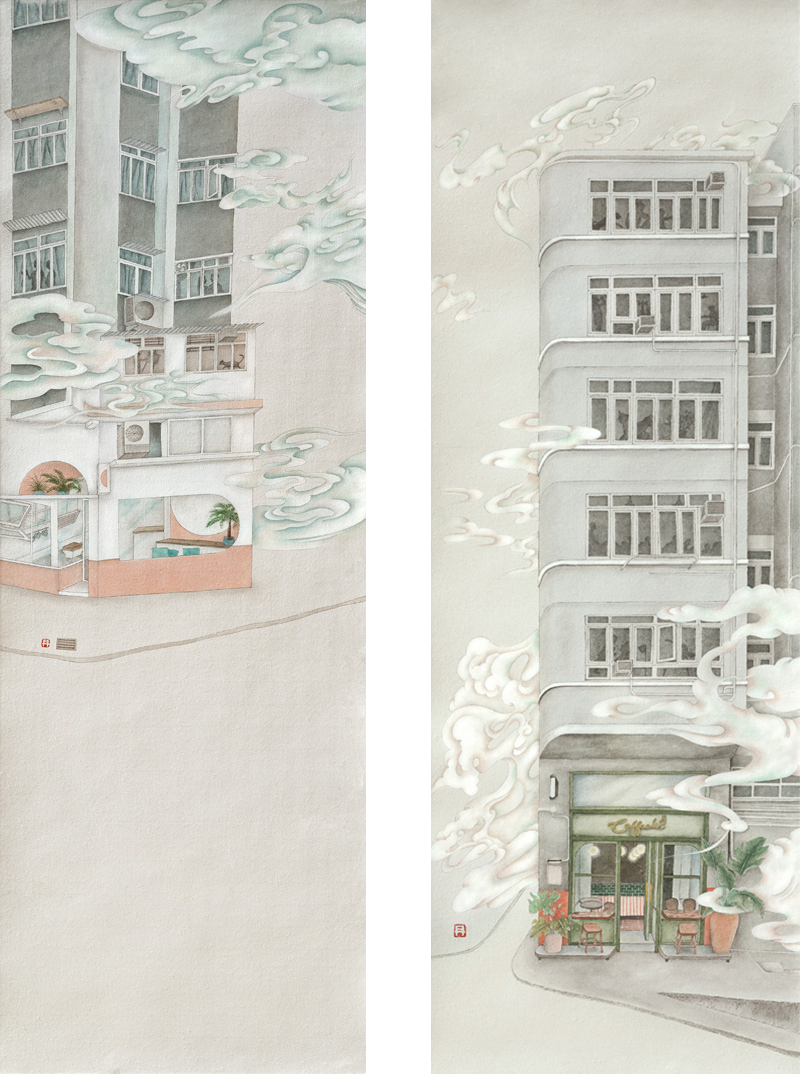鄭 丹 珊
Sam Cheng (lives and works in Hong Kong) graduated from the Fine Arts Department at the Chinese University of Hong Kong (CUHK) in 2014. Through precise fine-brush (gongbi) techniques in her paintings of landscapes and everyday life, she explores the expression of thoughts and feelings with line and gives further power to her emotions using subtle, lyrical ink washes and shading.
Cheng has participated in several local and overseas exhibitions, including Art Taipei (2019, 2021), Ink Asia (2018), Fine Art Asia (2014, 2016), and two solo exhibitions in Hong Kong. She received several awards from CUHK, and her works are mostly held by private collections.
鄭丹珊,香港居住及工作,2014年畢業於香港中文大學藝術系,取得一級榮譽文學士。鄭氏以細緻精準的工筆技巧描繪山水和日常景觀,探索用線條表達思想和情感,並揉合線、墨和色三者成為一個和諧的整體,產生一種墨氣沉着端莊,色澤恬淡幽靜,線條剛柔並濟的視覺語言,使其畫作更富意境和感染力。
鄭氏曾參與多個本地及海外聯展,包括「台北國際藝術博覽會」(2019,2021),「亞洲水墨藝博」(2018), 「典雅藝博」(2014,2016)等,並在香港舉辦兩次個展。鄭氏在香港中文大學就讀期間獲得多個獎項,作品多為私人收藏。
Artist’s Statement
I studied painting from a young age, and I have worked with a lot of different creative media. I found fine-brush painting in university, and I was immediately entranced by the delicate lines and the interweaving of ink and colour. Creating fine-brush paintings requires complete concentration, and it helps me find a Pure Land within a chaotic city. My creative subjects come from life, chosen somewhat spontaneously, and through imagination, I express my own feelings about my surroundings and society.
Hong Kong’s tong lau are tenement buildings mostly located on Hong Kong Island and in Kowloon. Tong lau have been a distinctive part of Hong Kong’s urban landscape since the nineteenth century.
Hong Kong has a high population density, so tong lau are invariably nestled against or connected to one another. In some places, you may be able to take a step off of one building’s balcony and onto the balcony of another building. Tong lau often have shops on the ground floor and residential units above, and the overhang on the first floor forms an arcade covering the pedestrians outside the shops, shielding the bustling crowds from the wind and rain.
With the passage of time, improvements in building technologies, and the increased demand for residential space, high-rises replaced tong lau. The tong lau that remain now represent “old” Hong Kong. In recent years, hipsters have also noticed the distinctive charms of these buildings, and coffee shops have moved in, bringing with them a young clientele. This fusion of old and new, Chinese and Western cultures has helped preserve the tong lau and inject new life into them.
Older tong lau and fashionable coffee shops, just like traditional gongbi painting and modern exhibition spaces, can contrast in a wonderful way.
藝術家自述
自幼習畫,曾涉獵不同類型的創作媒介,大學時期始接觸工筆畫。工筆線條細膩,墨與色彩交織變化,令我瞬間着迷。而創作工筆畫需要全神貫注,亦令我從煩囂的城市中找到一片靜土。我的創作主題源自生活,較為隨心,再透過想像,以抒發個人對周圍環境及社會的情感。
香港的唐樓是唐人聚居的民宅,多位處港島和九龍地區。自十九世紀起,一座座唐樓點綴香港,構成獨有的都市景觀。
香港地少人多,唐樓亦不得不互相依偎,彼此相連。若從天台邊緣跨出一步,或許便能走進另一樓房的天台。唐樓地下單位多為店舖,樓上單位則為民居,而一樓的「騎樓」覆蓋店外的行人路,為熙來攘往的市民遮風擋雨。
時移世易,隨着建築技術提升,及居住需求增加,高樓大廈取締了唐樓。至今仍保留下來的唐樓,成為了「老香港」的代言詞。而近年不少文青咖啡室,也垂青其獨有魅力,紛紛進駐其中,吸引年輕人慕名而來。這種新舊、中西文化交融,不但令唐樓得以保存,也為其注入生命力。
舊式的唐樓與時尚的咖啡室,傳統的工筆畫與現代的展覽廳,彼此相映成趣。



